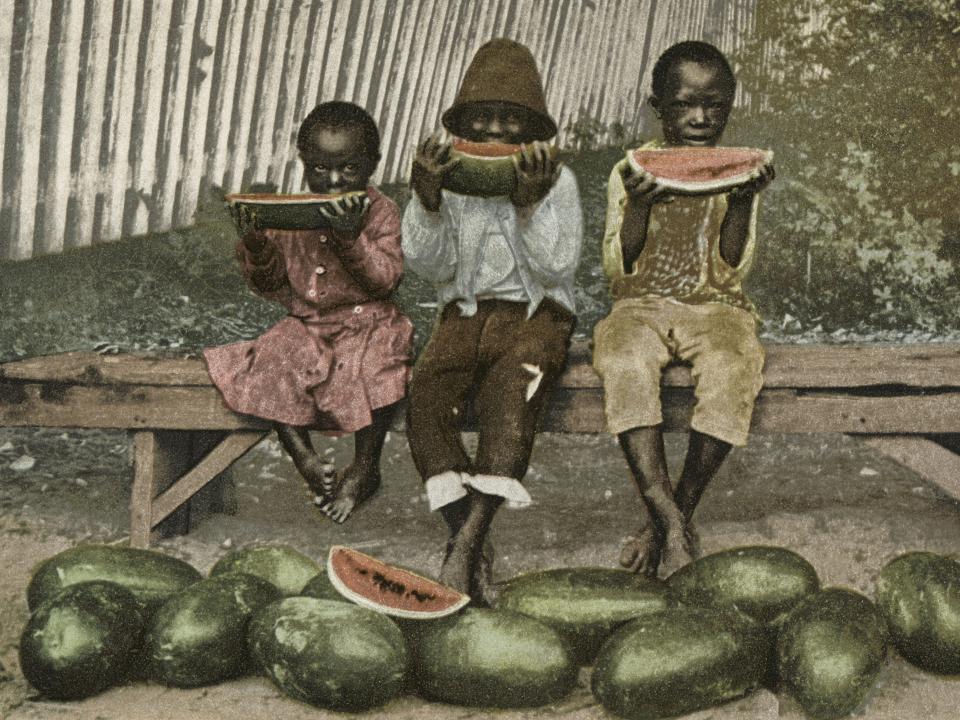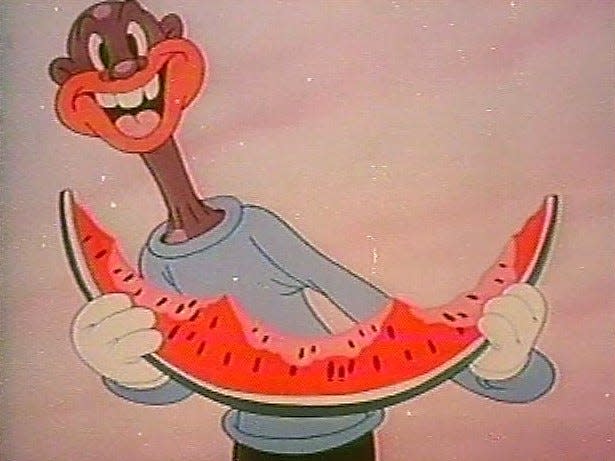How the watermelon stereotype came to be weaponized against Black Americans

For centuries, watermelon has been used alongside negative imagery of Black Americans.
Watermelon was first seen as a demeaning symbol in the 19th century when freed Black Americans became merchants and sold the fruit.
These stereotypes persisted into the 20th and 21st centuries.
For centuries, Black Americans have had to endure painful watermelon stereotypes. That hasn't changed in recent years.
In May 2022, NBC reported that six Florida middle-schoolers posted a photo of themselves on social media holding up a letter to spell out a racial slur, sparking outrage in the community. One letter appeared to be shaped like a watermelon.
In 2014 political cartoonist Jerry Holbert designed a comic of then-President Barack Obama using watermelon-flavored toothpaste for the Boston Herald.
At the National Book Awards in 2014, author Daniel Handler — perhaps best known by his pseudonym Lemony Snicket — joked about Jacqueline Woodson's watermelon allergy after she won an award that night for her book "Brown Girl Dreaming." Handler quipped that he'd write about "a Black girl being allergic to watermelon," as long as he had consent from Black icons like Toni Morrison, Cornel West, and then-President Barack Obama. Woodson responded eloquently and emotively to the remark in her 2014 New York Times op-ed, "The Pain of the Watermelon Joke": "By making light of that deep and troubled history, [Handler] showed that he believed we were at a point where we could laugh about it all." Woodson wrote. "His historical context, unlike my own, came from a place of ignorance."
The origins of watermelon
Although stereotypes about the fruit are primarily associated with the American South and Black American culture, the fruit's vines stem all the way back to the African continent.
The origins of watermelon can be dated back approximately 6,000 years ago when it was domesticated throughout Sudan, Egypt, Ethiopia, Libya, and Kenya. Enjoyed by royalty like the Egyptian King Tutankhamen, watermelon soon made it to Rome and Greece, later becoming cultivated in Spain after the Arab conquest.
Ancient Greeks praised watermelon for its healing and restorative properties, and prescribed them to people as a diuretic and to children as treatment for heatstroke.
By the 7th century watermelon had made its way to India, and by the 10th century, it could be found in China. It is thought that it wasn't until the late 16th century and early 17th century that watermelon was introduced to the Americas through European colonists and through the transatlantic slave trade from Africa. Thomas Jefferson's gardens at Monticello were known to have grown the fruit.
By the mid-to-late 19th century, watermelon began to become racialized. Around the time of the Civil War, negative descriptions about African American watermelon-eaters started becoming more prominent.
According to researcher William R. Black, enslaved people would sometimes negotiate informal contracts with their owners to cultivate and sell their own crops on designated plots of land on the plantations they worked on. As watermelons were easy to grow, they became a popular choice. Black quotes one former enslaved person as saying, "We never had our own gardens, but we had small watermelon patches."
'A taste of freedom'
Post-emancipation after the Civil War ended, newly freed African Americans continued to grow watermelons and sold them to generate income for themselves.
"Newly emancipated Africans employed their farming and entrepreneur abilities to produce and sell items like watermelon and the like," Howard University Afro American Studies lecturer Dr. Jo Von McCalester told Insider. "Personal gardens and their ability to sell its goods after completing their obligations, fostered a taste of freedom driven by their own efforts and on their own terms."
However, this new economic model upset some former slave owners in the South, who were angered that formerly subjugated African Americans had carved out a lucrative business niche for themselves and were enjoying the fruits of their labor.
"This air of freedom among those formerly enslaved further humiliated Southern whites," Dr. McCalester said. "The sheer audacity for Freed Africans to persevere in spite of their deplorable action, caused the concerted effort and sharp response of Southern whites to create a racist trope around the fruit and freed Africans."
Smear campaigns
Throughout the Jim Crow era, smear campaigns involving African Americans eating watermelon began to be spread, partially as a form of bigotry, but also as an attempt to squash African American businesses. Ads and ephemera used images of African Americans "stealing, fighting over, or sitting in streets eating watermelon," in an effort to "shame Black watermelon merchants," according to the National Museum of African American History and Culture.
Degrading African Americans by way of watermelon also acted as a ploy to derail Black people from gaining and sustaining positions of power.
"By associating the fruit with ideas like ignorance, uncleanliness, and laziness, refusing to accept their participation in society, politics, business, etc., is viewed as justified," Dr. McCalester said."Their consumption of watermelon was an outward expression of their inward inferiority."
Movies like the 1915 film "The Birth of a Nation" aided in cementing the watermelon stereotype with their "watermelon feast" scene. The film portrayed Black people being coaxed by white Northerners to quit working and eat watermelon after emancipation, implying that free Black people were going to be burdensome workers in America.
In 1941, Universal Pictures released "Scrub Me Mama with a Boogie Beat," an animated film that inhumanely distorted Blackness, reiterating racist notions that all Black people do is laze around and jig while over-indulging in watermelon in lieu of laboring.

Caricatures persist into the 20th century
The Jim Crow museum at Ferris State University holds countless memorabilia illustrating exaggerated and dehumanizing examples of the watermelon stereotype.
"The museum has dozens of three dimensional objects showing African Americans eating watermelons, including banks, ashtrays, toys, firecrackers, cookie jars, match holders, dolls, souvenirs, doorstops, lawn jockeys, and novelty objects," according to Ferris State University. "These objects not only show Blacks lustily eating watermelons but often portray African Americans in physically caricatured ways: hideous faces, over-sized bright red lips, darting eyes, and ragged clothing."
"The stigma associated with dark skin, oversized smiles, and red lips eating watermelon, has caused so many to socialize younger generations to steer clear of the fruit, Dr. McCalester said. "The backlash and perception of being associated with the fruit can even be seen contemporarily, even if Black People don't fully understand the historic implications of consuming the fruit."
Read the original article on Insider


